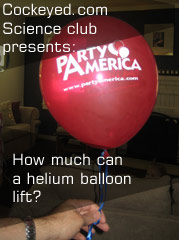


When it comes to cheap special effects, helium balloons are one of the most popular. They go up! Whoo hoo! When I was growing up, there were three things to do with helium balloons.
Now that I'm a little older, and a little better financed, I have glorious visions of riding a helium-lifted bicycle, floating over the London rooftops just like Oliver Twist in E.T. |
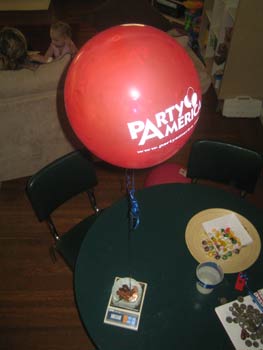
I had my first failed attempt at helium-powered lifting in 2002, on the campus of the University of New Orleans. Professor Wendy and I attempted to get aerial video footage of "How Much is Inside an Acre?". The lifting power of our balloons was completely defeated by strong winds off of Lake Pontchartrain. I'll definitely try again some day, but on Sunday, I just did a little background work, to figure out just how much a helium balloon can lift.
I began with a typical 11" diameter red helium balloon, complete with 26 inches of blue curling ribbon. To test the lifting power, I taped a paper baking cup to the end of the ribbon, and loaded it down with a handful of coins. I placed the whole assembly onto my trusty AND digital scale. |
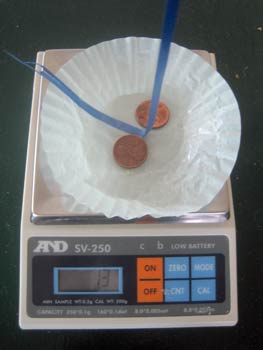
I slowly removed coins until the weight was just enough to anchor the balloon. Only two pennies were required. The lifting power of the helium gas was being offset by the weight of the two pennies, the baking cup, the tape, the ribbon, and the balloon itself. Those weights were just slightly greater than the lift of the helium gas: 1.3 grams greater, as shown on the scale.
|
The two pennies weighed 5.6 grams, the paper baking cup weighed 0.4 grams, and the tape weighed 0.1 gram. Subtracting 1.3grams from those three weights (5.6g+0.4g+0.1g)-(1.3g) gives us our most useful answer: A typical helium-filled balloon on a ribbon can lift 4.8 grams.
But! What if I cut the ribbon off? Or if I used featherweight thread? What if I found a super-light balloon? Then how much could one balloon of helium lift? |
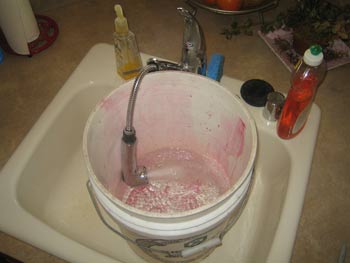
To measure the lift of the helium without the balloon, I needed to add the weight of the ribbon, and the latex balloon itself to the 4.8 grams. Simple enough, but before I popped the balloon, I wanted to obtain one more measurement: The volume of helium in the balloon.
To do that, I filled up my Kikkoman Soy Sauce bucket with water from the sink. This is the same type of bucket that the infamous Yakuza use for their water-displacement experiments. |
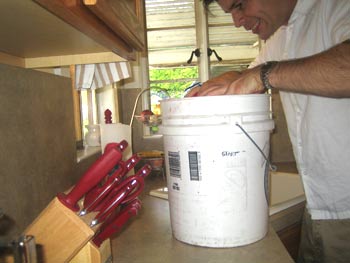
I planned to measure the amount of water the helium balloon displaced if I shoved it underwater within the bucket. After making a mark for where the water-level was at the start, I forced the balloon completely underwater. Oh, that balloon was scared. It wanted out of that bucket, out of that water, out of our house and out to the upper reaches of our atmosphere. The balloon and I both knew. He was never getting out of this place in one piece. |
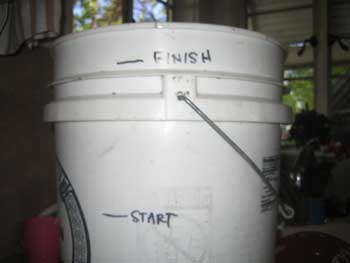
With the balloon submerged, I marked the finish level of the water. The balloon had pushed the water level about four inches higher. |
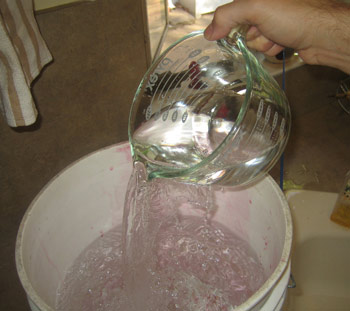
I pulled the sputtering balloon out, and carefully filled the bucket, quart by quart. When I had added 34 and a half cups of water, the bucket was full to the Finish mark, showing me that the balloon held about 34-1/2 cups, or 8.2 liters of helium. |

Having revealed all it could in life, I stuck that little red balloon with a fatal blow. It let out a sickly, high-pitched whine and died.
On the coroner's scale, I spread out the paper baking cup, and placed him there, wrapped him up with his own little ribbon. I put one penny over each eye, and took a final measurement: 9.6 grams. The helium, which had held him up though his life, was gone. His legacy will live on, through you, in these numbers: (9.6 g - 1.3 g) = 8.3 grams of lift per 8.2 liters of helium. Thank you. |
|
Cockeyed Airmail | cockeyed science club | cockeyed home | Contact Rob | May 3rd, 2006